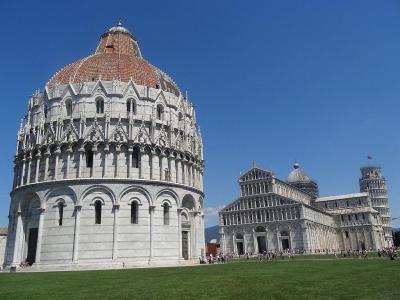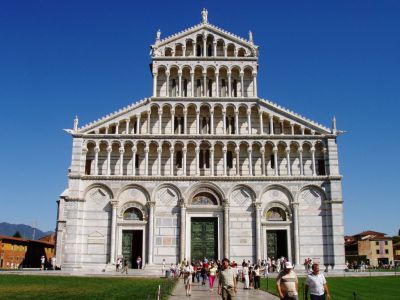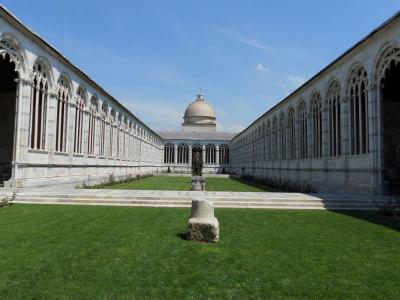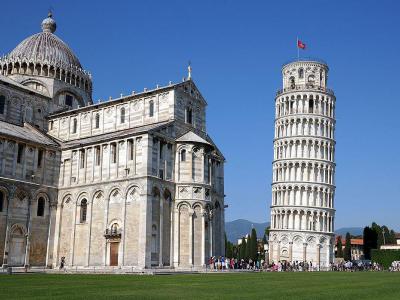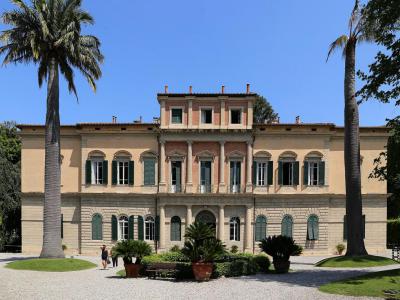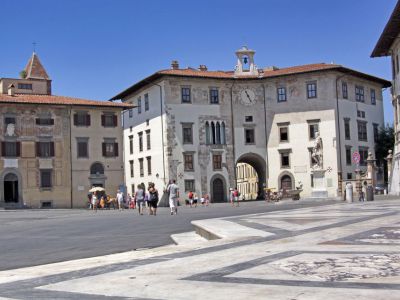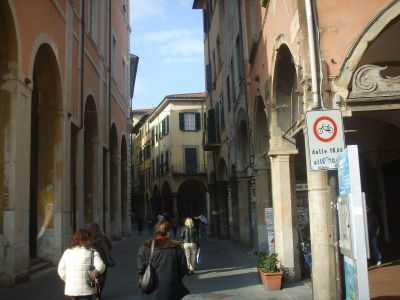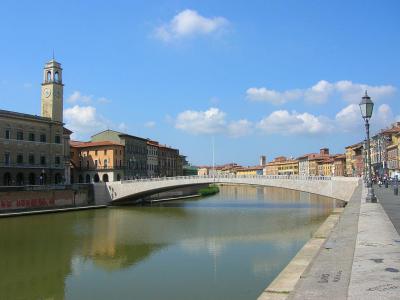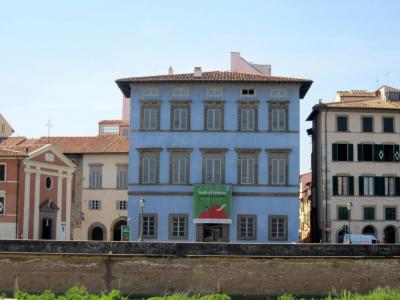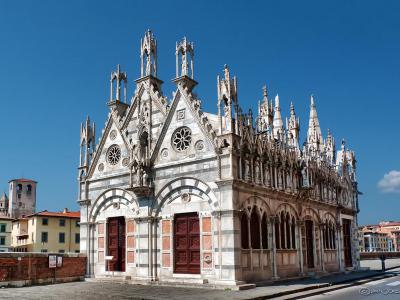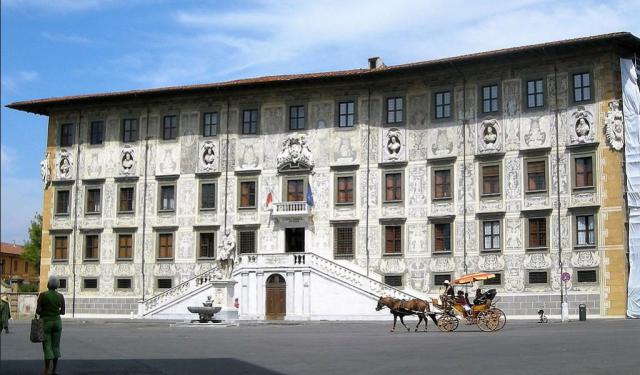Pisa Introduction Walking Tour (Self Guided), Pisa
The city of Pisa, in Italy's Tuscany region, is best known worldwide for its iconic Leaning Tower, as well as for being the birthplace of Galileo Galilei, whom considered by many as the Father of Modern Science.
The origin of the name Pisa is a mystery, while the origin of the city itself – as Etruscan – was confirmed only in 1991.
Founded on the seashore (which had since moved west), Pisa played a prominent maritime role for centuries. In 180 BC, it became a colony of the Roman Republic and served as a base for Roman naval expeditions and defense against sea pirates.
As a maritime nation and commercial center, Pisa enjoyed rapid growth with its apex reached in the 11th century. Much of the city's Romanesque architecture was built during that period.
The decline of Pisan naval power started in the 13th century. In 1405, the city was conquered by the Florentines. It lost its commercial position when the Arno River changed its course, cutting off the direct access to the sea. After the Medici came to power in the 15th century, Pisa lost its political significance, too.
But that did not stop the city from playing a significant role in the development of modern science and innovation, thanks to the pioneering work by Galileo Galilei and the emergence of the University of Pisa – its botanical garden, founded in 1544, is the oldest university botanical garden in Europe.
Despite repeated destruction during World War II, much of the city's architectural heritage has survived, and today includes more than 20 historic churches, several medieval palaces, and various bridges across the Arno.
Piazza del Duomo, also known, since the 20th century, as Piazza dei Miracoli (Square of Miracles), to the north of the old town center, is dominated by the Romanesque, striped-marble Duomo (the Cathedral, built in 1063), the Baptistry (renowned for its acoustics) and the Campo Santo (monumental cemetery). The Cathedral's belfry, commonly known as "the Leaning Tower of Pisa", is the most recognizable local landmark. When completed in 1372, the 56m white-marble cylinder bell tower was already tilting.
Other notable sights in the city include Piazza dei Cavalieri (Knights Square) – home to the impressive Palazzo della Carovana; Borgo Stretto (Narrow Street) – one of Pisa's most noteworthy promenades and top fashion zones; and Tuttomondo Mural by Keith Haring, painted in 1989; to mention but a few.
If you wish to explore these and other prominent landmarks of Pisa in more detail, take this self-guided introductory walk.
The origin of the name Pisa is a mystery, while the origin of the city itself – as Etruscan – was confirmed only in 1991.
Founded on the seashore (which had since moved west), Pisa played a prominent maritime role for centuries. In 180 BC, it became a colony of the Roman Republic and served as a base for Roman naval expeditions and defense against sea pirates.
As a maritime nation and commercial center, Pisa enjoyed rapid growth with its apex reached in the 11th century. Much of the city's Romanesque architecture was built during that period.
The decline of Pisan naval power started in the 13th century. In 1405, the city was conquered by the Florentines. It lost its commercial position when the Arno River changed its course, cutting off the direct access to the sea. After the Medici came to power in the 15th century, Pisa lost its political significance, too.
But that did not stop the city from playing a significant role in the development of modern science and innovation, thanks to the pioneering work by Galileo Galilei and the emergence of the University of Pisa – its botanical garden, founded in 1544, is the oldest university botanical garden in Europe.
Despite repeated destruction during World War II, much of the city's architectural heritage has survived, and today includes more than 20 historic churches, several medieval palaces, and various bridges across the Arno.
Piazza del Duomo, also known, since the 20th century, as Piazza dei Miracoli (Square of Miracles), to the north of the old town center, is dominated by the Romanesque, striped-marble Duomo (the Cathedral, built in 1063), the Baptistry (renowned for its acoustics) and the Campo Santo (monumental cemetery). The Cathedral's belfry, commonly known as "the Leaning Tower of Pisa", is the most recognizable local landmark. When completed in 1372, the 56m white-marble cylinder bell tower was already tilting.
Other notable sights in the city include Piazza dei Cavalieri (Knights Square) – home to the impressive Palazzo della Carovana; Borgo Stretto (Narrow Street) – one of Pisa's most noteworthy promenades and top fashion zones; and Tuttomondo Mural by Keith Haring, painted in 1989; to mention but a few.
If you wish to explore these and other prominent landmarks of Pisa in more detail, take this self-guided introductory walk.
How it works: Download the app "GPSmyCity: Walks in 1K+ Cities" from Apple App Store or Google Play Store to your mobile phone or tablet. The app turns your mobile device into a personal tour guide and its built-in GPS navigation functions guide you from one tour stop to next. The app works offline, so no data plan is needed when traveling abroad.
Pisa Introduction Walking Tour Map
Guide Name: Pisa Introduction Walking Tour
Guide Location: Italy » Pisa (See other walking tours in Pisa)
Guide Type: Self-guided Walking Tour (Sightseeing)
# of Attractions: 12
Tour Duration: 2 Hour(s)
Travel Distance: 3.0 Km or 1.9 Miles
Author: nicole
Sight(s) Featured in This Guide:
Guide Location: Italy » Pisa (See other walking tours in Pisa)
Guide Type: Self-guided Walking Tour (Sightseeing)
# of Attractions: 12
Tour Duration: 2 Hour(s)
Travel Distance: 3.0 Km or 1.9 Miles
Author: nicole
Sight(s) Featured in This Guide:
- Piazza dei Miracoli (Miracles Square)
- Duomo di Pisa (Pisa Cathedral)
- Camposanto Monumentale (Monumental Cemetery)
- Battistero di San Giovanni (Pisa Baptistery)
- The Leaning Tower
- Orto Botanico (Botanical Garden)
- Piazza dei Cavalieri (Knights Square)
- Borgo Stretto (Narrow Street)
- Ponte di Mezzo (Middle Bridge)
- Palazzo Blu (Blue Palace)
- Santa Maria della Spina Church
- Tuttomondo Mural
1) Piazza dei Miracoli (Miracles Square) (must see)
The Miracles Square is, of course, at the top of your “must see” list in Pisa. It is the most famous and most visited square in Europe after Saint Peter’s Square in Rome. It is a walled area and its real name is the Cathedral Square but the writer Gabriele D’Annunzio dubbed it the Square of Miracles in one of his books and the name stuck. Many people misguidedly call it the "Field of Miracles" but that field was invented by Carlo Collodi in his book “The Adventures of Pinocchio”. In Collodi's book, two scoundrels, the Cat and the Fox, told Pinocchio that if he planted his gold there it would grow into money trees.
The square is made up of an area that is partly paved and partly neatly trimmed lawns and some of the most famous buildings in Pisa are found on this square. The three buildings (Baptistery, Cathedral, Hospital) and the Cemetery are said to represent the four stages of human.
If we take them in these stages in chronological order, we start with the Pisa Baptistery, dedicated to Saint John the Baptist, represents Birth. The Pisa Cathedral portrays Life, while the New Hospital of the Holy Spirit represents Illness and the end of life. The cemetery, of course, represents Death.
The other famous building on the square, the bell tower of the Cathedral – also known as the Leaning Tower – doesn’t come into the allegory, but if you are in a whimsical frame of mind you might say that it represents the rather shaky path humans take during their Life!
The square is made up of an area that is partly paved and partly neatly trimmed lawns and some of the most famous buildings in Pisa are found on this square. The three buildings (Baptistery, Cathedral, Hospital) and the Cemetery are said to represent the four stages of human.
If we take them in these stages in chronological order, we start with the Pisa Baptistery, dedicated to Saint John the Baptist, represents Birth. The Pisa Cathedral portrays Life, while the New Hospital of the Holy Spirit represents Illness and the end of life. The cemetery, of course, represents Death.
The other famous building on the square, the bell tower of the Cathedral – also known as the Leaning Tower – doesn’t come into the allegory, but if you are in a whimsical frame of mind you might say that it represents the rather shaky path humans take during their Life!
2) Duomo di Pisa (Pisa Cathedral) (must see)
The Pisa Cathedral is the medieval cathedral that stands on the Miracles Square and it is a fine example of Italian-Romanesque architecture.
Busketo began work on the building in 1064 and his tomb is built into the façade in white stone and grey marble with colored marble discs. You will see an inscription about the foundation of the Cathedral and Pisa’s victory against the Saracens.
On the eastern end of the building there is the replica of the Pisa Griffon. The 11th century original, which is the largest known Islamic metal sculpture, can be seen in the Cathedral Museum.
The huge bronze doors were added after the original wooden ones were destroyed by fire in 1595. Above the doors are four rows of open galleries; there is a statue of the Madonna and Child and the Four Evangelists. Worshippers usually enter the church by a door built in 1180 by Pisano on the bell tower side of the cathedral.
The interior of the cathedral has black and white marble facings and the mosaics are in Byzantine style. The granite Corinthian columns come from the mosque in Palermo, which was captured by Pisa in 1063.
The gilded ceiling and frescoed dome were restored after the 1595 fire, as was the nave’s coffer ceiling. The fresco of “Christ in Majesty with the Virgin Mary and Saint John the Evangelist” luckily survived the fire and can be find in the apse.
To mark the beginning of the Pisan new year a system was devised in the cathedral whereby a beam of light shines through a round window on the south side of the nave and, precisely at noon on March 25, lands on the same spot every year: on top of a shelf affixed to a pylon on the opposite side of the church. The lamp at the center of the nave is called Galileo's lamp, because a legend says that the great scientist formulated his theory of isochronism of the pendulum while watching its oscillations from the roof of the nave. The original, however, smaller and very different than this one, is found today in the Camposanto.
Galileo Galilei was consecrated as a scientist here.
Busketo began work on the building in 1064 and his tomb is built into the façade in white stone and grey marble with colored marble discs. You will see an inscription about the foundation of the Cathedral and Pisa’s victory against the Saracens.
On the eastern end of the building there is the replica of the Pisa Griffon. The 11th century original, which is the largest known Islamic metal sculpture, can be seen in the Cathedral Museum.
The huge bronze doors were added after the original wooden ones were destroyed by fire in 1595. Above the doors are four rows of open galleries; there is a statue of the Madonna and Child and the Four Evangelists. Worshippers usually enter the church by a door built in 1180 by Pisano on the bell tower side of the cathedral.
The interior of the cathedral has black and white marble facings and the mosaics are in Byzantine style. The granite Corinthian columns come from the mosque in Palermo, which was captured by Pisa in 1063.
The gilded ceiling and frescoed dome were restored after the 1595 fire, as was the nave’s coffer ceiling. The fresco of “Christ in Majesty with the Virgin Mary and Saint John the Evangelist” luckily survived the fire and can be find in the apse.
To mark the beginning of the Pisan new year a system was devised in the cathedral whereby a beam of light shines through a round window on the south side of the nave and, precisely at noon on March 25, lands on the same spot every year: on top of a shelf affixed to a pylon on the opposite side of the church. The lamp at the center of the nave is called Galileo's lamp, because a legend says that the great scientist formulated his theory of isochronism of the pendulum while watching its oscillations from the roof of the nave. The original, however, smaller and very different than this one, is found today in the Camposanto.
Galileo Galilei was consecrated as a scientist here.
3) Camposanto Monumentale (Monumental Cemetery) (must see)
The Monumental Cemetery stands at the northern edge of the Miracles Square and took its name “Monumental” to distinguish it from other later cemeteries. The cemetery is said to have been built around sacred earth brought back from Golgotha in the 12th century by the Archbishop of Pisa, Ubaldo de’Lanfranchi.
According to legend bodies buried here decay within 24 hours. The cemetery was the fourth and last building to be erected on the square and it stands on the ruins of the first Baptistery. It is an oblong shaped Gothic style building started by di Simone in 1278. Building was completed in 1464. At the beginning of its construction, it was intended to be a church, but the plans were changed after the western end was completed.
The outer wall has 43 blind arches and two doorways. Over the right-hand entrance you will see a tabernacle containing sculptures of the Virgin and Child and four Saints, created in the 14th century by Giovanni Pisano. Most of the tombs are under the arches, once there were many Roman sarcophagi, but today only 84 remain.
The building houses three chapels: the Chapel Ammannati is the oldest, dating back to 1360; the Chapel Aulla was built in 1518 and has an altar made by della Robbia; the Chapel Dal Pozzo was added in 1594.
In the Aulla chapel we can see also the original incense lamp that Galileo Galilei used for calculation of pendular movements. This lamp is the one Galileo saw inside the cathedral, now replaced by a larger more elaborate one.
In 1944 American bombing caused a fire which destroyed most of the cemetery’s marvelous frescoes. These were removed and ongoing restoration work began on them in 1954 with the intention of returning them to their original places.
According to legend bodies buried here decay within 24 hours. The cemetery was the fourth and last building to be erected on the square and it stands on the ruins of the first Baptistery. It is an oblong shaped Gothic style building started by di Simone in 1278. Building was completed in 1464. At the beginning of its construction, it was intended to be a church, but the plans were changed after the western end was completed.
The outer wall has 43 blind arches and two doorways. Over the right-hand entrance you will see a tabernacle containing sculptures of the Virgin and Child and four Saints, created in the 14th century by Giovanni Pisano. Most of the tombs are under the arches, once there were many Roman sarcophagi, but today only 84 remain.
The building houses three chapels: the Chapel Ammannati is the oldest, dating back to 1360; the Chapel Aulla was built in 1518 and has an altar made by della Robbia; the Chapel Dal Pozzo was added in 1594.
In the Aulla chapel we can see also the original incense lamp that Galileo Galilei used for calculation of pendular movements. This lamp is the one Galileo saw inside the cathedral, now replaced by a larger more elaborate one.
In 1944 American bombing caused a fire which destroyed most of the cemetery’s marvelous frescoes. These were removed and ongoing restoration work began on them in 1954 with the intention of returning them to their original places.
4) Battistero di San Giovanni (Pisa Baptistery) (must see)
Construction on the Pisa Baptistery began in 1152. Designer Diotisalvi signed an interior pillar with the date 1153, but the Baptistery wasn't completed until 1363.
The impressive marble Pisa Baptistery is the largest baptistery in Italy and stands at 54.86 meters (180 feet) tall, making it almost as tall as its neighbor, the Leaning Tower. The lower portion represents Romanesque styling, whereas the upper sections with pointed arches are Gothic.
Two classical columns flank the portal. The lintel has two tiers. The lower tier portrays several scenes from John the Baptist's life. The upper tier shows John the Baptist surrounded by Christ, the Madonna, and angels.
The interior features 12 columns that represent the 12 apostles. A bronze sculpture of John the Baptist stands in the center of the baptismal font. The font's three steps represent The Father, Son, and Holy Spirit. Famed astronomer and scientist Galileo was baptized here in 1564.
The pulpit was sculpted by Nicola Pisano and completed in 1260. The artistry represents a new focus on more realistic art and represents the beginning of the Italian Renaissance period.
The Pisa Baptistery was built on the same sand as the leaning tower and leans 0.6 degrees. Visitors can climb to the viewing level and look out over the Piazza dei Miracoli (Square of Miracles).
Tips:
Every half an hour, a guardian comes in to say a few words and demonstrate Pisa Baptistery's unique acoustics. This is a good time to be on the upper viewing level, as the acoustics here are impressive.
The impressive marble Pisa Baptistery is the largest baptistery in Italy and stands at 54.86 meters (180 feet) tall, making it almost as tall as its neighbor, the Leaning Tower. The lower portion represents Romanesque styling, whereas the upper sections with pointed arches are Gothic.
Two classical columns flank the portal. The lintel has two tiers. The lower tier portrays several scenes from John the Baptist's life. The upper tier shows John the Baptist surrounded by Christ, the Madonna, and angels.
The interior features 12 columns that represent the 12 apostles. A bronze sculpture of John the Baptist stands in the center of the baptismal font. The font's three steps represent The Father, Son, and Holy Spirit. Famed astronomer and scientist Galileo was baptized here in 1564.
The pulpit was sculpted by Nicola Pisano and completed in 1260. The artistry represents a new focus on more realistic art and represents the beginning of the Italian Renaissance period.
The Pisa Baptistery was built on the same sand as the leaning tower and leans 0.6 degrees. Visitors can climb to the viewing level and look out over the Piazza dei Miracoli (Square of Miracles).
Tips:
Every half an hour, a guardian comes in to say a few words and demonstrate Pisa Baptistery's unique acoustics. This is a good time to be on the upper viewing level, as the acoustics here are impressive.
5) The Leaning Tower (must see)
The Leaning Tower of Pisa is the most famous freestanding bell tower in the world. It was built between 1173 and 1372 as a companion to the Pisa Cathedral.
The ground floor features a blind arcade with Corinthian columns. The second floor was added in 1178, and the tower began to sink in the soft, sandy soil. Construction was then halted for almost a century as the Republic of Pisa engaged in battles with their neighbors.
Construction restarted in 1272, and the upper floors were built with one side taller than the other to compensate for the already leaning tower. Finally, in 1319, the seventh floor was completed, and the bell tower was added in 1372.
Between 1589 and 1592, Galileo Galilei (then professor of mathematics at the University of Pisa) dropped two spheres of different masses from the Leaning Tower of Pisa to demonstrate that their time of descent was independent of their mass. Galileo discovered through this experiment that the objects fell with the same acceleration, proving his prediction true, while at the same time disproving Aristotle's theory of gravity which states that objects fall at speed proportional to their mass.
The tower has impressively survived at least four major earthquakes. The combination of the height of the tower and the soft soil helped it resist earthquake damage.
In more recent years, efforts have been made to stabilize the tower, stop it from toppling over, and keep this historic building intact as a Pisa landmark. The tower was closed from 1990-2001 to effect this stabilization. At that time, the tower was leaning at a 5.5-degree angle (4.5 meters or 15 feet).
In 1990, the bells were removed to take away some of the weight of the building. Cables were added to the third level and anchored hundreds of meters away. Counterweights were added in 1993 to keep the tower from toppling over. Engineers worked to reduce the tilt by shifting soil from underneath the tower. The tilt was reduced by 45 centimeters and matched the 1838 tilt level.
The structural interventions were so successful that the tower has been stable, and no additional leaning has occurred.
The Leaning Tower now leans by 3.97 degrees, or 3.9 meters (12 feet 10 inches). The original height of the tower was 60 meters. Today it is 56.67 meters on the high side and 55.86 meters on the low side.
Why You Should Visit:
No visit to Pisa is complete without seeing this iconic landmark in person. Don't forget your camera for cheesy "holding up the tower" photos and the view from the top.
Tips:
Visitors can climb the 251 steps and enjoy the fantastic views from the top. Children under eight are not permitted to climb. It's advisable to buy tickets in advance to this busy and popular attraction.
The ground floor features a blind arcade with Corinthian columns. The second floor was added in 1178, and the tower began to sink in the soft, sandy soil. Construction was then halted for almost a century as the Republic of Pisa engaged in battles with their neighbors.
Construction restarted in 1272, and the upper floors were built with one side taller than the other to compensate for the already leaning tower. Finally, in 1319, the seventh floor was completed, and the bell tower was added in 1372.
Between 1589 and 1592, Galileo Galilei (then professor of mathematics at the University of Pisa) dropped two spheres of different masses from the Leaning Tower of Pisa to demonstrate that their time of descent was independent of their mass. Galileo discovered through this experiment that the objects fell with the same acceleration, proving his prediction true, while at the same time disproving Aristotle's theory of gravity which states that objects fall at speed proportional to their mass.
The tower has impressively survived at least four major earthquakes. The combination of the height of the tower and the soft soil helped it resist earthquake damage.
In more recent years, efforts have been made to stabilize the tower, stop it from toppling over, and keep this historic building intact as a Pisa landmark. The tower was closed from 1990-2001 to effect this stabilization. At that time, the tower was leaning at a 5.5-degree angle (4.5 meters or 15 feet).
In 1990, the bells were removed to take away some of the weight of the building. Cables were added to the third level and anchored hundreds of meters away. Counterweights were added in 1993 to keep the tower from toppling over. Engineers worked to reduce the tilt by shifting soil from underneath the tower. The tilt was reduced by 45 centimeters and matched the 1838 tilt level.
The structural interventions were so successful that the tower has been stable, and no additional leaning has occurred.
The Leaning Tower now leans by 3.97 degrees, or 3.9 meters (12 feet 10 inches). The original height of the tower was 60 meters. Today it is 56.67 meters on the high side and 55.86 meters on the low side.
Why You Should Visit:
No visit to Pisa is complete without seeing this iconic landmark in person. Don't forget your camera for cheesy "holding up the tower" photos and the view from the top.
Tips:
Visitors can climb the 251 steps and enjoy the fantastic views from the top. Children under eight are not permitted to climb. It's advisable to buy tickets in advance to this busy and popular attraction.
6) Orto Botanico (Botanical Garden) (must see)
The Botanical Garden was the first university botanical garden in Europe when it was founded in 1544. It has been in its current location since 1591.
Today, it is a beautiful place to stroll through, appreciate nature, and discover botanical treasures.
The garden has several sections, including gardens, ponds, the botanical school, and greenhouses. The old botany institute was completed in 1595 and features a sea-shell facade.
The Pharaonic collection is especially impressive and represents horticultural treasures found in ancient Egyptian tombs. The garden also has aquatic plants that are so endangered there are no longer found in nature. The water gardens have lovely pools and fountains.
The Botanical Garden features a Botanical Museum founded by the Grand Tuke of Tuscany in 1591. The museum has portraits of famous botanists and various artworks. The Herbarium features 350,000 samples, including a variety of seagrasses.
Today, it is a beautiful place to stroll through, appreciate nature, and discover botanical treasures.
The garden has several sections, including gardens, ponds, the botanical school, and greenhouses. The old botany institute was completed in 1595 and features a sea-shell facade.
The Pharaonic collection is especially impressive and represents horticultural treasures found in ancient Egyptian tombs. The garden also has aquatic plants that are so endangered there are no longer found in nature. The water gardens have lovely pools and fountains.
The Botanical Garden features a Botanical Museum founded by the Grand Tuke of Tuscany in 1591. The museum has portraits of famous botanists and various artworks. The Herbarium features 350,000 samples, including a variety of seagrasses.
7) Piazza dei Cavalieri (Knights Square) (must see)
During medieval times, Knights' Square was Pisa's political center. Before that, it was likely the site of the Roman Forum.
In 1406, Florence's emissary announced the end of Pisa's independence in this square.
In the 16th century, Cosimo I de Medici, the Grand Duke of Tuscany, commissioned Vasari to recreated the square in Renaissance style. The Knights of Saint Stephen had recently inaugurated the Order of the Knights, and the square was dedicated to them. The Order of the Knights of Saint Stephen was established to defend the coast from Turkish pirates.
A 1596 statue of the Grand Duke of Tuscany stands in the center of the square.
Knights Square is home to several landmark buildings. The Cavalieri Palace was also called Palace of the Convoy due to the three-year training Order initiates undertook here. The palace is adorned with artistic graffiti representing allegorical figures, zodiac signs, and busts representing the Grandukes of Tuscany.
The Clock Palace is famous as the site where Count Ugolino was held prisoner and died of starvation. Today, the palace is home to the University library.
The Puteano College was established in 1605. In addition, the Consiglio dei Dodici Palace features valuable 18th-century paintings.
The Church of the Knights of the Holy and Military Order of Saint Stephen was designed by Vasari and completed in 1569. Inside, visitors will see naval banners captured by successful Knights of Saint Stephen.
In 1406, Florence's emissary announced the end of Pisa's independence in this square.
In the 16th century, Cosimo I de Medici, the Grand Duke of Tuscany, commissioned Vasari to recreated the square in Renaissance style. The Knights of Saint Stephen had recently inaugurated the Order of the Knights, and the square was dedicated to them. The Order of the Knights of Saint Stephen was established to defend the coast from Turkish pirates.
A 1596 statue of the Grand Duke of Tuscany stands in the center of the square.
Knights Square is home to several landmark buildings. The Cavalieri Palace was also called Palace of the Convoy due to the three-year training Order initiates undertook here. The palace is adorned with artistic graffiti representing allegorical figures, zodiac signs, and busts representing the Grandukes of Tuscany.
The Clock Palace is famous as the site where Count Ugolino was held prisoner and died of starvation. Today, the palace is home to the University library.
The Puteano College was established in 1605. In addition, the Consiglio dei Dodici Palace features valuable 18th-century paintings.
The Church of the Knights of the Holy and Military Order of Saint Stephen was designed by Vasari and completed in 1569. Inside, visitors will see naval banners captured by successful Knights of Saint Stephen.
8) Borgo Stretto (Narrow Street) (must see)
If you want to do some shopping or simply wander through the narrow streets of medieval Pisa, you should go to the Narrow Street. This long street is mostly pedestrian and filled with shops from simple stores selling books and souvenirs to some of the most exclusive shops in the city.
Most of the street is lined on each side with arcades supported by Corinthian columns. In the arcades you will find plenty of bars, restaurants and shops. Look for Café Settimelli. Over the arched entrance to the Café Settimelli a sign proudly announces that this was once the house of the Galilei family and Galileo was born there.
The two and three story houses on both sides of the street were once the homes of rich merchant families. On the corner of via San Francesco you will find the 15 century Poschi Palace. There are plenty of narrow side streets leading off the Narrow Street and some of these will lead you to delightful open air markets that sell flowers, fresh fruits and vegetables.
Most of the street is lined on each side with arcades supported by Corinthian columns. In the arcades you will find plenty of bars, restaurants and shops. Look for Café Settimelli. Over the arched entrance to the Café Settimelli a sign proudly announces that this was once the house of the Galilei family and Galileo was born there.
The two and three story houses on both sides of the street were once the homes of rich merchant families. On the corner of via San Francesco you will find the 15 century Poschi Palace. There are plenty of narrow side streets leading off the Narrow Street and some of these will lead you to delightful open air markets that sell flowers, fresh fruits and vegetables.
9) Ponte di Mezzo (Middle Bridge)
To get from the north side of the River Arno to the south side, you will cross the river by the Middle Bridge. In Roman times a wooden bridge spanned the river a little further upstream. This bridge was replaced by a stone one in 1035 and was restored in 1388. In 1635 it collapsed and was rebuilt in 1660. The “new” bridge was an elegant affair with three arches and carved balustrades and named “Middle” as it was (more-or-less) in the center of the city. This bridge was destroyed in 1944 during wartime bombing.
The bridge you will cross today was built in 1950 out of reinforced concrete sheathed in white Verona stone. It is 89 meters long and had one arch of 72 meters. At the four corners of the bridge are marbles globes from the former bridge. In the center of the bridge you will see the Pisan cross laid out in white stone paving.
If you are lucky enough to be in the city in June, you will certainly take part in the Pisa June which is a series of carnivals that re-enact historical events. The highlight of the Pisa June is the Bridge Game, held on the last Saturday of the month, when rival teams from the Mezzoiorno District and the Tramontana District “battle” for control of the bridge. The two teams of twenty pit their strength against each other by pushing against a heavy cart set on tracks in the middle of the bridge. The team who manages to push the cart to the “enemy” camp, wins the game.
The bridge you will cross today was built in 1950 out of reinforced concrete sheathed in white Verona stone. It is 89 meters long and had one arch of 72 meters. At the four corners of the bridge are marbles globes from the former bridge. In the center of the bridge you will see the Pisan cross laid out in white stone paving.
If you are lucky enough to be in the city in June, you will certainly take part in the Pisa June which is a series of carnivals that re-enact historical events. The highlight of the Pisa June is the Bridge Game, held on the last Saturday of the month, when rival teams from the Mezzoiorno District and the Tramontana District “battle” for control of the bridge. The two teams of twenty pit their strength against each other by pushing against a heavy cart set on tracks in the middle of the bridge. The team who manages to push the cart to the “enemy” camp, wins the game.
10) Palazzo Blu (Blue Palace)
Situated on the banks of the River Arno, this site has been settled since the 11th century. Parts of Blue Palace date back to the 16th century. Many famous and influential families have owned this stately palace throughout the centuries.
It was renovated in the 19th century, and a wing was added to make the palace symmetrical. During this renovation, the facade was painted its current iconic blue color. The interior features rich embellishments typical of the 19th century. Blue Palace's first floor is decorated and furnished to represent a 19th-century aristocratic palace.
The Blue Palace houses the Museum of Art and Culture in Pisa. The collection features more than 300 works of art that span from the 14th to the 20th centuries. Artists represented include Nino Pisano, Cecco di Pietro, and Benozzo Gozzoli.
The museum also hosts archeological records from Pisa's history, including the Etruscan, Roman, and Hellenistic eras. The underlying road, which dates to the 12th or 13th centuries, is visible on the ground floor.
The museum often hosts temporary exhibitions with various fascinating themes such as space or Dante's Inferno.
It was renovated in the 19th century, and a wing was added to make the palace symmetrical. During this renovation, the facade was painted its current iconic blue color. The interior features rich embellishments typical of the 19th century. Blue Palace's first floor is decorated and furnished to represent a 19th-century aristocratic palace.
The Blue Palace houses the Museum of Art and Culture in Pisa. The collection features more than 300 works of art that span from the 14th to the 20th centuries. Artists represented include Nino Pisano, Cecco di Pietro, and Benozzo Gozzoli.
The museum also hosts archeological records from Pisa's history, including the Etruscan, Roman, and Hellenistic eras. The underlying road, which dates to the 12th or 13th centuries, is visible on the ground floor.
The museum often hosts temporary exhibitions with various fascinating themes such as space or Dante's Inferno.
11) Santa Maria della Spina Church
This tiny church boasts one of the most outstanding Gothic edifices in all of Europe. It's a simple rectangular building, but the exterior is built entirely of marble and features ornate cusps, tympani, and tabernacles. There are detailed sculptures all over the walls, plus rose windows and many 14th century statues.
The church was built in 1230 and then enlarged in 1325. It was originally known as Santa Maria Di Pontenovo in honor of a bridge that existed at the time. Unfortunately, that bridge collapsed in the 1400s and was never rebuilt.
At one time, the church was home to a thorn--allegedly part of the Crown of Thorns placed on Christ's head during his Crucifixion. The relic is now on display at Santa Chiara Church, but this church has kept the name "della spina" or "of the thorn."
The church was renovated in 1871 to raise it above the flood level of the Arno River. The church was altered to the extent that locals and visitors like Englishman John Ruskin were outraged.
The interior of the church is rather spartan compared to the outside. This is because the ceiling was painted during the 19th-century renovations. A masterpiece of Gothic sculpture stands in the center--Madonna of the Rose by Andrea and Nino Pisano.
The church was built in 1230 and then enlarged in 1325. It was originally known as Santa Maria Di Pontenovo in honor of a bridge that existed at the time. Unfortunately, that bridge collapsed in the 1400s and was never rebuilt.
At one time, the church was home to a thorn--allegedly part of the Crown of Thorns placed on Christ's head during his Crucifixion. The relic is now on display at Santa Chiara Church, but this church has kept the name "della spina" or "of the thorn."
The church was renovated in 1871 to raise it above the flood level of the Arno River. The church was altered to the extent that locals and visitors like Englishman John Ruskin were outraged.
The interior of the church is rather spartan compared to the outside. This is because the ceiling was painted during the 19th-century renovations. A masterpiece of Gothic sculpture stands in the center--Madonna of the Rose by Andrea and Nino Pisano.
12) Tuttomondo Mural
The southern exterior wall of the Church of Sant'Antonio Abate hosts this enormous mural. It was painted in 1989 and is one of the last works of famous American artist, Keith Haring, before he succumbed to AIDS-related complications.
Tuttomondo means "all the world." Haring described the work as one of his most important projects. The 180-meter-tall mural depicts 30 figures created in Haring's cartoon style. The theme is peace and harmony.
Of note in the mural are the man defeating the evil serpent, the woman and baby, which represent maternity, and figures supporting dolphins representing man's connection to and relationship with nature.
The mural is a popular spot. Not only do many people come to admire the outstanding example of modern art, but many think it's the perfect place for a Pisa selfie. Opposite the mural, you'll find the Keith Café and Art Shop--the perfect place to grab a bite to eat and sip on a cup of coffee while admiring this stunning mural.
Tuttomondo means "all the world." Haring described the work as one of his most important projects. The 180-meter-tall mural depicts 30 figures created in Haring's cartoon style. The theme is peace and harmony.
Of note in the mural are the man defeating the evil serpent, the woman and baby, which represent maternity, and figures supporting dolphins representing man's connection to and relationship with nature.
The mural is a popular spot. Not only do many people come to admire the outstanding example of modern art, but many think it's the perfect place for a Pisa selfie. Opposite the mural, you'll find the Keith Café and Art Shop--the perfect place to grab a bite to eat and sip on a cup of coffee while admiring this stunning mural.
Walking Tours in Pisa, Italy
Create Your Own Walk in Pisa
Creating your own self-guided walk in Pisa is easy and fun. Choose the city attractions that you want to see and a walk route map will be created just for you. You can even set your hotel as the start point of the walk.
Galileo's Pisa Walking Tour
Among the names that hardly need introduction there is one of Galileo Galilei. The most illustrious son of Pisa, this 16th-17th century physicist, mathematician, astronomer and philosopher went down in history as the “Father of Modern Science” and is forever cherished as one of the world’s greatest minds.
As Galileo's hometown, Pisa boasts a number of places linked to his life, of... view more
Tour Duration: 1 Hour(s)
Travel Distance: 1.8 Km or 1.1 Miles
As Galileo's hometown, Pisa boasts a number of places linked to his life, of... view more
Tour Duration: 1 Hour(s)
Travel Distance: 1.8 Km or 1.1 Miles
Pisa Palaces Walking Tour
As you continue your acquaintance with Pisa, you will notice that there is a lot more to see here than just a "leaning" landmark. Indeed, just like Italy in general, this particular Tuscan city boasts a glorious heritage of wonderful palaces, fit to transport you back in time.
The most beautiful palaces in Pisa are found on both sides of the Arno River, forming a multi-colored ribbon... view more
Tour Duration: 1 Hour(s)
Travel Distance: 2.1 Km or 1.3 Miles
The most beautiful palaces in Pisa are found on both sides of the Arno River, forming a multi-colored ribbon... view more
Tour Duration: 1 Hour(s)
Travel Distance: 2.1 Km or 1.3 Miles
The Most Popular Cities
/ view all



